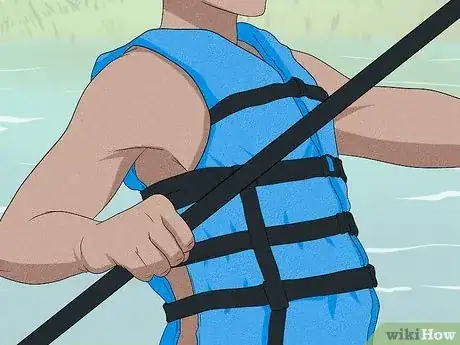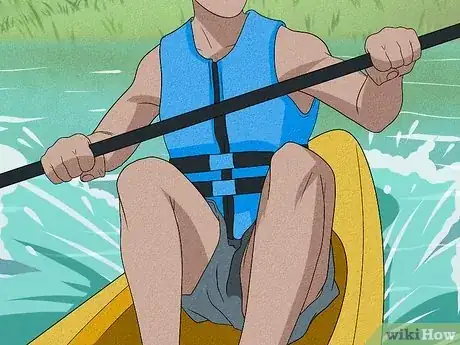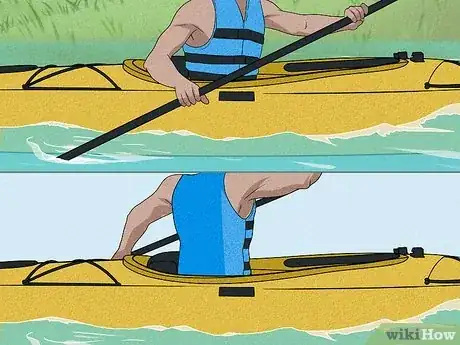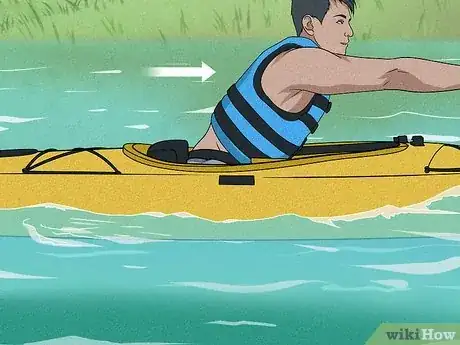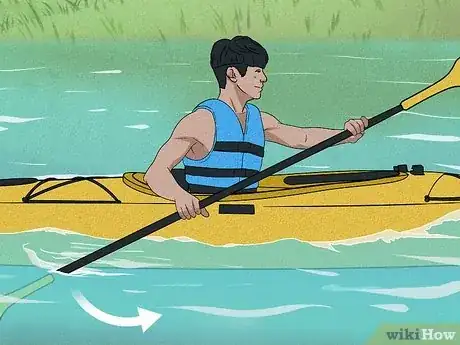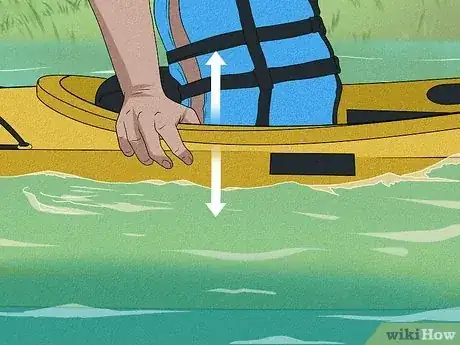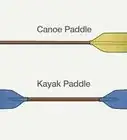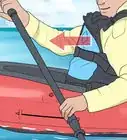This article was co-authored by wikiHow staff writer, Madeleine Flamiano. Madeleine Flamiano is an Editing Fellow at wikiHow based in Berkeley, California, as well as a Team Organizer, Copy Editor, and Movie Critic for Incluvie. Madeleine has 12 years of experience in literacy advocacy and the creative arts that span tutoring, teaching, writing, public relations, and non-profit support. She has penned seven novels under a pseudonym and loves all escapist genres, from cozy fantasies to hard-boiled sci-fi. Her professional path started at NaNoWriMo, where she scripted and hosted a series on worldbuilding. Madeleine graduated from Mills College with a B.A. in English with a concentration in Literature and a Minor in Philosophy.
There are 19 references cited in this article, which can be found at the bottom of the page.
This article has been viewed 1,185 times.
Learn more...
When you’re in a wild kayak, there’s no reason to panic—you can take complete control of the situation. You just have to make sure to stay safe, especially in rapids and whitewater. We’ll share how to brush up on your skills and take the right precautions. That way, you can paddle and steer a wild kayak with confidence. To keep your calm out in the waters, review this handy guide for beginners.
Steps
Remain calm in rough waters.
-
Staying relaxed allows you to think clearly. When you’re in a high-anxiety situation in rough waters, take deep breaths and focus on your movements. Pay attention to where the rapids are on the river and reflect on the best techniques to navigate them. As you kayak in whitewater, assess which areas are safest based on your skill level.[1] X Research source
- Remember that understanding river dynamics gives you the best advantage.
- Avoid any places in the water that look like they're outside of your kayaking skill level, even if you think they'd be fun. It's best to wait until you've picked up more advanced training.
Distribute your weight evenly to stay balanced.
-
The right stance will help you stay upright while you paddle. Keep a low center of gravity—put as much weight as possible on your sit bones and your feet. Look out ahead of you to scan for any changes in water conditions. As you paddle, keep your hands low to stay steady and balanced in your kayak.[2] X Research source
- When you sit upright, you keep your weight distributed on your sit bones and feet. If you do this, you "brace" yourself and can easily shift your body whenever you need to "side surf," or ride a wave.
- If you hold the same posture and keep your paddle low, you won’t need to overthink. When there’s a change in conditions, you’ll be more likely to react because you’re alert instead of anxious.
Keep your feet on the foot pegs.
-
Stay in this position to maximize your strength and control your kayak. Sit up straight, keep your knees slightly bent, and rest your feet on the foot pegs. Make sure your elbows are at a right angle and that you softly grip your paddle—your hands should be shoulder width apart.[3] X Research source
- If you don’t move your legs or feet, you’ll save your stamina so you can steer your kayak more easily
Use your upper body to paddle.
-
Turn or accelerate easily by paddling with your arms and torso. Rotate your torso and use your arms to pull or push your paddle—this allows you to execute the "push-pull" technique so you can push the upper paddle blade and pull the lower paddle blade. [4] X Research source
- As you rotate, make sure you relax your grip on your paddle. If your knuckles turn white, you’re gripping it too tightly and cutting off your circulation.
- You save energy and avoid fatigue with the "push-pull" strategy, so you'll be able to paddle at a high speed for longer periods of time.
Activate your core muscles with each stroke.
-
Engage your core for stronger, more efficient strokes. Sit up straight and keep your torso tight. As you paddle, lead with your hand and shoulder. Twist from your belly button to fully drive your paddle through the water.[5] X Research source If your core is activated as you paddle, your strokes will be more powerful.[6] X Research source
- When you keep your core tight, you avoid fatigue and protect your shoulders from tiring out.
Sweep your paddle blade to move right or left.
-
Use your hips and core to rotate the paddles and steer your kayak. Try “opposite side paddling” to redirect water around your paddle’s blade. Dip your paddle into the water behind you—keep it parallel to your kayak. Sweep the blade out in an arc while you push the bow of your kayak in the opposite direction. You’ll rotate your kayak with this technique.[7] X Research source
- Paddle on the right side of your kayak to turn left.
- Paddle on the left side of your kayak to turn right.
- If you need to completely rotate your kayak, it’s likely you’ll have to use the “opposite side paddling” strategy multiple times.
Use a “flat spin” technique to rotate 360°.
-
Position your kayak on a wave hole to turn your boat around. Find a wave hole—a small foam pile that forms when air mixes with water—and paddle your kayak to get on top of it. Once you’re on the wave hole and sliding with it, start a spin. First, sweep your paddle backwards and keep going until you’ve switched directions. Right before you’ve made a full 360° turn, flatten your boat. Then, lift your knee up and make a forward sweep with your paddle to move forward.[8] X Research source
- Lead with your head as you rotate your body and your kayak in the wave hole. It will help you sweep your paddle with ease.
- It’s important to flatten your kayak just before you paddle forward—timing this properly will let you pass through the wave hole and toward the direction you want to go in.
Tilt your kayak to surf waves.
-
Tip it to one side with your lower body to move with the flow of water. Lift your left knee to “edge,” or tilt, your kayak toward the right. Do the reverse to “edge” to your left—raise your right knee. Edge your kayak away from any oncoming current. If you hit a large wave, lean so you “dig” the edge of your kayak into it and surf it.[9] X Research source
- If you encounter a hydraulic or “hole” in the whitewater, perform a “back deck roll”—“edge” into it on one side of your kayak, then return your kayak to a flat, upright position again.[10] X Research source
Shift your weight to move your kayak.
-
Lean your body forward or backward to balance out your kayak. Bring your chest over your thighs and pull your knees up.[11] X Research source If whitewater has tilted your kayak too far up, lean forward to send the bow of the boat back down. When the waves have caused your kayak to dip too low, lean backwards to raise its bow.[12] X Research source
- Avoid leaning your body to the side if you need to keep your kayak upright. It may tip over and capsize.
- Leaning backward or forward prevents your kayaking from capsizing by keeping it “flat.”
Use a forward stroke to paddle faster.
-
Stroke your blade forward to accelerate with less effort. Place the blade of your paddle in the water and keep your lower arm straight. Relax your upper arm, then—depending on whether you plan to paddle to the right or the left—step down on the right or left footpeg. Drive or “spear” your paddle into the water. Keep the paddle vertical and end the stroke when your lower hand is level with your stomach.[13] X Research source
- If you need to speed up, try not to pull the paddle really far back—the traction, or resistance, can slow you down.
Paddle with a reverse stroke to go backward.
-
Sweep your blade behind you to switch directions. Look behind you to check for obstacles to steer clear of, like large rocks. “Anchor,” or position, the blade of your paddle in the water and behind your hip. Sweep the blade toward your hip and slice it out of the water. To continue paddling backwards, repeat this process on the other side of the kayak and alternate your motions.[14] X Research source
- As you paddle to reach your destination, try not to lean back. You’ll disengage your core and have more difficulty staying stable in your kayak.
- To avoid getting dizzy, focus on one spot and use short strokes when you paddle backwards.
Use short strokes to stop your kayak.
-
In an emergency, the “stopping stroke” helps slow your kayak down. If you see changes in the water that you’d like to avoid, place the paddle blade in the water. Push the blade away from your body. Use slow, gentle strokes to slow down the kayak. If you’re gliding quickly through the water, alternate the sides of your paddle strokes—that will keep the kayak balanced as you bring it to a stop.[15] X Research source
- The “stopping stroke” is similar to the reverse stroke but uses shorter, choppier motions.
Move with the weather conditions if you lose control.
-
If the wind or rough waters spin your kayak, move with your boat. Instead of fighting conditions like strong winds or turbulent waves by overcorrecting your strokes, paddle in the same direction your kayak is going. For example, if a gust of wind has shifted your kayak to the right, just paddle it that way. It’ll be easier to control your kayak because you won’t tire yourself out by resisting the weather patterns or waves.[16] X Research source
- In some cases, you may need to paddle harder in order to adjust to heavy winds.
Use a bilge pump to remove water from your kayak.
-
Suction out excess water with the bilge pump and throw it out. Whether rain or waves have filled your kayak with water, take out your bilge pump to get rid of it. Place the bottom of the pump in the water, then press the handle down to suction the water out of the kayak. Pick the bilge pump up and hold it over the side of the kayak. Press the handle down again to dump the water out of the exit tube.[17] X Research source
- Invest in an automatic bilge pump as an extra safety precaution. This device allows you to automatically suction water while you continue to paddle.
Perform a wet exit if a kayak flips over.
-
Remove yourself from the boat with a beginner-friendly wet exit. When your kayak has tipped over and capsized, take a breath before you go underwater. If your kayak doesn’t have a skirt, then put your knees together, grab the rim of your cockpit, and pull yourself out of the boat.[18] X Research source
- For a kayak that’s attached with a skirt, lean forward and pull its grab loop. Extend your arms and lean forward. Then, put your knees together and push yourself out of the kayak.
- If you can’t find the grab loop, bend your knees so the kayak’s skirt pops off or grab the side of the skirt and yank it off the cockpit.
You Might Also Like

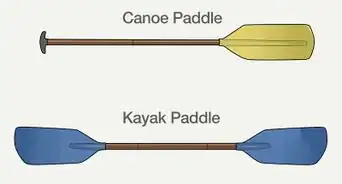
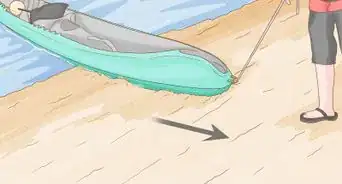


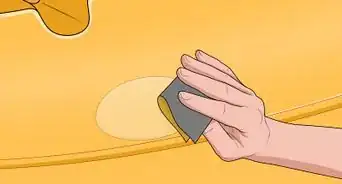

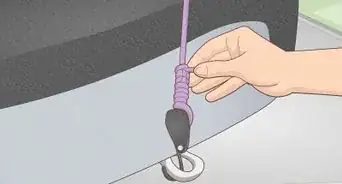






References
- ↑ https://www.team4adventure.com/blog/whitewater-kayaking-for-you/
- ↑ https://www.active.com/outdoors/articles/kayak-clinic-how-to-perfect-your-forward-stroke-873787
- ↑ https://activelyoutdoor.com/kayak-foot-pegs-and-braces/
- ↑ https://www.myactivesg.com/sports/canoeing/training-method/canoeing-for-beginners/how-to-use-a-kayak-paddle
- ↑ https://paddling.com/learn/the-kayak-stroke-finesse-over-power
- ↑ https://aquabound.com/blogs/resources/are-you-making-this-common-paddling-mistake
- ↑ https://threesisterskayakrental.com/steer-a-kayak/
- ↑ https://www.nswatersports.co.uk/blog/2020/09/16/top-playboating-tricks-anyone-can-master/
- ↑ https://paddlingmag.com/skills/strokes-techniques/how-to-edge-a-kayak/
- ↑ https://mindbodypaddle.com/508/glossary-of-basic-white-water-kayaking-terms/
- ↑ https://www.mensjournal.com/adventure/messing-longboat-tips-surfing-sea-kayak/
- ↑ https://www.useakayak.org/surf_zone/side_hit_wave.html
- ↑ https://www.kayaktutorial.com/2-2
- ↑ https://coolofthewild.com/how-to-paddle-a-kayak/
- ↑ https://paddling.com/learn/basic-kayak-strokes
- ↑ https://www.ez-dock.com/blog/kayaking-for-beginners/
- ↑ https://paddlegeek.com/how-to-use-a-kayak-bilge-pump-before-your-boat-sinks/
- ↑ https://www.olympicoutdoorcenter.com/blogs/expert-advice/how-to-do-a-kayak-wet-exit
- ↑ https://www.ez-dock.com/blog/what-to-bring-on-a-kayak-trip/
About This Article




